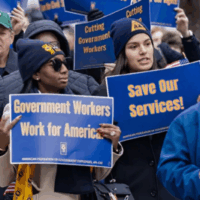This week, California’s Governor Gavin Newsom stated that complying with the new indoor heat safety rule would be too expensive for the California Department of Corrections and Rehabilitation (CDCR). Nearly 20 years after California’s ground-breaking outdoor heat standard was passed, and after decades of indoor workers demanding protection from entirely preventable heat illnesses and injuries in warehouses, fast food restaurants, and delivery trucks, at the 11th hour, the entire rule was in question when the state cynically pitted incarcerated workers and corrections officers against all other indoor workers.
His argument against including tens of thousands of incarcerated workers because it would cost California taxpayers too much in wages is only possible within a conceptual framework rooted in slavery and racial bias that sees work in this context as redeeming punishment and not labor worthy of legal protections.
We have seen this kind of retributive and exclusionary thinking before. A new NELP report, Workers Doing Time Must Be Protected by Job Safety Laws, finds that many states, including California, rely on state-designed disaster recovery plans that depend on incarcerated labor to prevent and respond to natural disasters while denying the workers basic health and safety protections using justifications rooted in slavery and anti-Blackness.
As of 2023, California incarcerated nearly 97,000 people with people of color overrepresented in the carceral population. While white people are incarcerated at a rate of 143 per 100,000 state residents in the state’s prisons and a rate of 153 per 100,000 in its jails, Black people are incarcerated at rates of 1,349 and 727 per 100,000 respectively, and Indigenous people are incarnated at rates of 934 and 483 per 100,000.
An estimated 64,788 of California’s incarcerated people are also workers either within the carceral facility itself or under contract for public works or prison-sponsored manufacturing.
There are more than 38,000 California workers classified as correctional officers and jailers. The CDCR also employs thousands of other workers like teachers, librarians, and counselors. Nearly three-quarters of these workers identify as BIPOC, and 28 percent are women.
And carceral workplaces can get excruciatingly hot. In August of 2021 when wildfires hit in rural Northern California near the Nevada border, power lines went down and the generator at the California Correctional Center failed for almost a month. According to the National Weather Service, daytime temperatures that month rose to the mid- to high-90s. There were 1,080 corrections staff working there, along with 2,064 incarcerated people, many of whom also performed work inside the facility. The CCC has since closed, but it was not alone in being vulnerable to climate dangers including excessive heat.
According to research by the Ella Baker Center, at least 8 of California’s state prisons are located in areas with extreme heat. A report from the CDCR itself acknowledges that 5 facilities that once experienced fewer than 5 days above the extreme heat threshold annually will see as many as 24 days by mid-century and potentially 41 days by 2070.
By exploiting the 13th Amendment loophole that allows for coerced labor in the carceral system, the system trains workers and their communities to accept low standards and poor treatment outside of the facility. This form of labor governance shapes the overall economy by infusing underpaid work with anti-Blackness, acceptance of dangerous and degraded work, and notions of work as punishment for prior behavior or even simply for being poor.
All of California’s workers deserve protection from occupational heat stress. As we find in our new report on gaps in OSHA protections for incarcerated disaster workers, the abolition of coerced labor entirely is a matter of basic human rights and dignity, but as an immediate first step, federal lawmakers must pass the Correctional Facilities Occupational Safety and Health Act of 2023 to extend workplace safety and health protections to incarcerated workers not just in California, but in all states.




